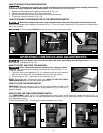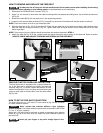
17
1. To see if the table support plate is mounted on a flat plane and parallel to the drum, use a 3/16" (5 mm) hex
wrench (A) Fig. 38 and a 1/2" (12.7 mm) open-end wrench (B) to loosen the four hex bolts that attach the support
plate to the elevating bolts. Place a block of wood (C) Fig. 39 approximately 3/4" (19 mm) wide x 2" (51 mm) to 3"
(76 mm) tall under the table support plate on the unit base, next to one of the elevation bolts. Turn the elevating
bolt up or down until the support plate clears the block. REPEAT the clearance check at each of of the other three
elevation bolts. They should be within 1/64" (.4 mm) of each other (O) Fig. 41.
2. While holding the 1/2" (12.7 mm) hex on the bolt to prevent it from turning, retighten the four hex bolts.
3. With the 1/2" wrench and a 3/16" hex wrench, loosen the front right socket head bolt (B) Fig. 38 four full turns (S)
Fig. 40. Turn the elevating bolt clockwise until it no longer touches the plate (P) Fig. 40. Then turn the same bolt
counter-clockwise until it touches the support plate without raising it (O) Fig. 41. Hold the elevating bolt (L) Fig. 41
with the 1/2" wrench to keep it from turning. Tighten the socket head bolt (B) with the 3/16" hex wrench.
4. With the support plate level, move the table up and down. If the movement is still tight, repeat this procedure.
Fig. 38
STEP 2 - CHECKING THE TABLE SUPPORT PLATE
A
B
C
STEP 1 - TIMING BELT TENSION
1. If the timing belt is too tight, the table will be difficult to move. A loose timing belt may cause the belt to jump a
tooth on the timing gear. Deflection in the middle of the long span should be 2-3 lbs (.91 kg - 1.36 kg).
2. To adjust the tension, locate one of the timing belt idler rollers under the right-hand end of the unit between the
timing gears. Use a 1/2" wrench to loosen the bolt (the nut for this bolt can be seen on the topside of the base).
NOTICE
Do not rotate elevation handwheel while the belt tension is relaxed.
3. With the 1/2" wrench still on the idler bolt under the unit, push the slack of the belt toward the column end of the
unit, and tighten the bolt.
NOTICE
Be careful not to over-tighten the nut. This could crush the spacer inside. Approximately 50 inch/lbs
(5.6 N.m). of torque will be sufficient. To be certain that the spacer is not damaged, grasp the idler roller. If it can
move approximately 1/8" (3.2 mm) vertically, the spacer is all right.
4. With the proper belt tension, adjust the table.
Fig. 40
B
Fig. 41
O
S
P
P
B
L
L
B
Fig. 39


















